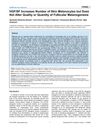L-Tyrosine HCL
Research
20 / 1000+ results
research Biotransformation of Finasteride by Ocimum Sanctum L., and Tyrosinase Inhibitory Activity of Transformed Metabolites: Experimental and Computational Insights
Fermentation of Finasteride with Ocimum sanctum L. creates new metabolite that inhibits tyrosinase.

research Cutaneous Metabolism of Vitamin B-6
An enzyme other than TNAP might be responsible for vitamin B-6 metabolism in the skin.

research HGF/SF Increases Number of Skin Melanocytes but Does Not Alter Quality or Quantity of Follicular Melanogenesis
HGF/SF increases skin melanocytes but doesn't change melanin type or amount.

research Finasteride Inhibits Melanogenesis Through Regulation of the Adenylate Cyclase in Melanocytes and Melanoma Cells
Finasteride reduces melanin production, possibly treating hyperpigmentation and melanoma, but needs more safety research.

research Pigmentation Effect of Rice Bran Extract in Hair Follicle-Like Tissue and Organ Culture Models
Rice bran extract boosts melanin production in hair follicles.

research Synergistic Effect of Rice Bran Extract and Extremely Low-Frequency Electromagnetic Fields on Dermal Papilla/Melanocytes in Melanogenesis
Rice bran extract and low-frequency electromagnetic fields together may help treat vitiligo and white hair.

research Cryogelation of Human Hair Keratins
Human hair keratins can be turned into useful 3D biomedical scaffolds through a freeze-thaw process.

research Human and Animal Cells Under Influence of Different Lighting and Stimuli
Different light affects cell functions and can help treat skin conditions.
research Mimosine Dipeptide Enantiomers: Improved Inhibitors Against Melanogenesis And Cyclooxygenase
Mimosine dipeptides are promising for treating hyperpigmentation and inflammation.
research Effects of Aging on Hair Color, Melanosomes, and Melanin Composition in Japanese Males and Their Sex Differences
As Japanese males age, their hair darkens due to increased melanin, with males generally having darker hair than females.
research Expression of Hypothalamic-Pituitary-Thyroid Axis Related Genes in Human Skin
Thyroid-related genes are active in skin cells and may affect autoimmune conditions.
research Retracted: Ascertaining the Influence of Lacto-Fermentation on Changes in Bovine Colostrum Amino and Fatty Acid Profiles
research Desmodesmus Pannonicus Water Extract Inhibits Melanin Synthesis and Promotes Wound Healing
Desmodesmus pannonicus water extract may help reduce skin pigmentation, heal wounds, and promote hair growth.
research Mechanism of Hair Curling via Laccase-Assisted Tyrosine Grafting Using BSA as a Model Protein
A gentler, less damaging method for curling hair using tyrosine works well initially but fades after washing.

research Structural and Functional Studies of L-PGDS and SMPDL3A Enzymes in Lipid Signaling Family
L-PGDS has specific binding sites for its functions and could help in drug delivery system design.

research Chemotherapy and Cutaneous Drug Reactions
Chemotherapy can cause skin side effects that affect patients' lives, but they can be managed to avoid interrupting cancer treatment.
research Impaired Hair Follicle Morphogenesis and Cycling with Abnormal Epidermal Differentiation in Nackt Mice, a Cathepsin L-Deficient Mutation
Cathepsin L deficiency causes hair and skin issues in mice.

research The Effect of Glycyrrhizic Acid and Aqueous Licorice Extract on Hair Growth Retardation: In Vitro Mechanistic and Efficacy Studies in Human
Glycyrrhizic acid and licorice extract can significantly reduce unwanted hair growth.

research Pregnenolone for the Treatment of L-DOPA-Induced Dyskinesia in Parkinson's Disease
Pregnenolone might help manage movement issues caused by Parkinson's disease treatment without reducing the medicine's effectiveness.

research Protein and Amino Acid Composition of Hair from Mice Carrying the Naked (N) Gene
The N gene affects the protein makeup of mouse hair.